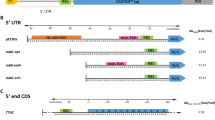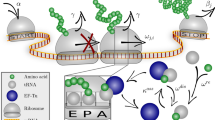Abstract
The impact of the codon bias of the mouse tumour necrosis factor α(mTNF) gene cloned inStreptomyces lividans on the efficiency of expression and secretion was analysed. Minor codons occurring in the mTNF gene were therefore adapted to the codon bias ofStreptomyces by site-directed mutagenesis. No improvement in mTNF yield could be detected. The stability of the transcript derived from the construct was shown to be more important for determining the final level of mTNF production. A strong correlation was observed between the yield of secreted biologically active mTNF and the amount of mTNF mRNA present in the cells.
Similar content being viewed by others
References
Anné J, Van Mellaert L (1993)Streptomyces lividans as host for heterologous protein production. FEMS Microbiol Lett 114:121–128
Bender E, Koller KP, Engels JW (1990) Secretory synthesis of human interleukin-2 byStreptomyces lividans. Gene 86:227–232
Brawner M (1994) Advances in heterologous gene expression byStreptomyces. Curr Opin Biotechnol 5:475–481
Chang SY, Chang S (1988) Secretion of heterologous proteins inStreptomyces lividans. In: Okami Y, Beppu T, Ogawara H (eds) Biology of Actinomycetes-88. Japan Scientific Society Press, Tokyo, Japan, pp103–107
Chen CY (1984) Homologous versus heterologous gene expression in the yeast,Saccharomyces cerevisiae. Nucleic Acids Res 12:8951–8970
Chen GFT, Inouye M (1990) Suppression of the negative effect of minor arginine codons on gene expression; preferential usage of minor codons within the first 25 codons of theEscherichia coli genes. Nucleic Acids Res 18:1465–1473
Devereux J, Haeberli P, Smithies O (1984) A comprehensive set of sequence analysis programs for the VAX. Nucleic Acids Res 12:387–395
Favaloro J, Treisman R, Kamen R (1980) Transcription maps of polyoma virus-specific RNA: analysis by two dimensional nuclease S1 gel mapping. Methods Enzymol 65:718–749
Fornwald JA, Donovan MJ, Gerber M, Keller J, Taylor DP, Arcuri EJ, Brawner ME (1993) Soluble forms of the human T cell receptor CD4 are efficiently expressed byStreptomyces lividans. Biotechnology 11:1031–1036
Gouy M, Gauthier C (1982) Codon usage in bacteria: correlation with gene expressivity. Nucleic Acids Res 10:7055–7074
Heremans H, Van Damme J, Dillen C, Dijkmans R, Billiau A (1990) Interferon-γ, a mediator of lethal lipopolysaccharide-induced Shwartzman-like shock reactions in mice. J Exp Med 171:1853–1869
Hopwood DA, Bibb MJ, Chater KF, Kieser T, Bruton CJ, Ward JM, Kieser HM, Lydiate DJ, Smith CP, Schrempf H (1985) Genetic manipulation ofStreptomyces: a laboratory manual. John Innes Foundation, Norwich, UK
Ikemura T (1981) Correlation between the abundance ofEscherichia coli transfer RNAs and the occurrence of the respective codons in its protein genes. J Mol Biol 146:1–21
Ikemura T (1982) Correlation between the abundance of yeast tRNAs and the occurrence of the respective codons in its protein genes. J Mol Biol 158:573–597
Leskiw BK, Mah R, Lawlor EJ, Chater KF (1993) Accumulation ofbldA-specified tRNA is temporally regulated inStreptomyces coelicolor A3(2). J Bacteriol 175:1995–2005
Lichenstein H, Brawner ME, Miles LM, Meyers CA, Young PR, Simon PL, Eckhardt T (1988) Secretion of interleukin-1β andEscherichia coli galactokinase byStreptomyces lividans. J Bacteriol 170:3924–3929
Miller JH (1972) Experiments in molecular genetics. Cold Spring Harbor Laboratory Press, Cold Spring Harbor, New York
Pulido D, Jiménez A (1987) Optimization of gene expression inStreptomyces lividans by a transcription terminator. Nucleic Acids Res 15:4227–4240
Robinson M, Lilley R, Little S, Emtage JS, Yarranton G, Stephens P, Millican A, Eaton M, Humphreys G (1984) Codon usage can affect efficiency of translation of genes inEscherichia coli. Nucleic Acids Res 12:6663–6671
Rosenberg AH, Goldman E, Dunn JJ, Studier FW, Zubay G (1993) Effects of consecutive AGG codons on translation inEscherichia coli, demonstrated with a versatile codon test system. J Bacteriol 175:716–722
Sambrook J, Fritsch EF, Maniatis T (1989) Molecular cloning. a laboratory manual, 2nd edn. Cold Spring Harbor Laboratory Press, Cold Spring Harbor, New York
Sanger F, Nicklen S, Coulson AR (1977) DNA sequencing with chain-terminating inhibitors. Proc Natl Acad Sci USA 74:5463–5467
Taguchi S (1992)Streptomyces subtilisin inhibitor: genetical characterization and its application. Actinomycetology 6:9–20
Ueda Y, Taguchi S, Nishiyama KI, Kumagai I, Miura KI (1993) Effect of a rare leucine codon, TTA, on expression of a foreign gene inStreptomyces lividans. Biochim Biophys Acta 1172:262–266
Van Mellaert L, Dillen C, Proost P, Sablon E, DeLeys R, Van Broekhoven A, Heremans H, Van Damme J, Eyssen H, Anné J (1994) Efficient secretion of biologically active mouse tumor necrosis factorα byStreptomyces lividans. Gene 150:153–158
Virolle MJ, Long CM, Chang S, Bibb M (1988) Cloning, characterization and regulation of anα-amylase gene fromStreptomyces venezuelae. Gene 74:321–334
Ward JM, Janssen GR, Kieser T, Bibb MJ, Buttner MJ, Bibb MJ (1986) Construction and characterisation of a series of multi-copy promoter-probe plasmid vectors inStreptomyces using the aminoglycoside phosphotransferase gene from Tn5 as indicator. Mol Gen Genet 201:468–478
Wright F, Bibb MJ (1992) Codon usage in the G + C-richStreptomyces genome. Gene 113:55–65
Yanisch-Perron C, Vieira J, Messing J (1985) Improved M13 phage cloning vectors and host strains: nucleotide sequences of the M13mp18 and pUC19 vectors. Gene 33:103–119
Zuker M (1990) On finding all suboptimal foldings of an RNA molecule. Science 244:48–52
Author information
Authors and Affiliations
Additional information
Communicated by C. A. M. J. J. van den Hondel
Rights and permissions
About this article
Cite this article
Lammertyn, E., Van Mellaert, L., Bijnens, A.P. et al. Codon adjustment to maximise heterologous gene expression inStreptomyces lividans can lead to decreased mRNA stability and protein yield. Molec. Gen. Genet. 250, 223–229 (1996). https://doi.org/10.1007/BF02174182
Received:
Accepted:
Issue Date:
DOI: https://doi.org/10.1007/BF02174182




